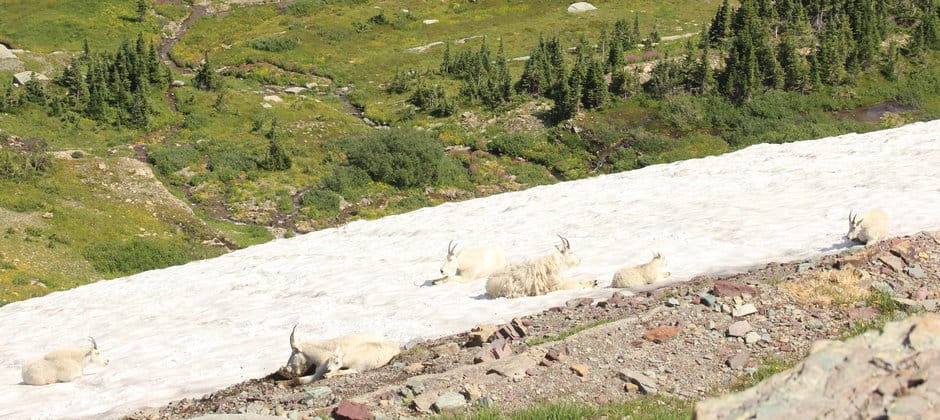Share this article
As the climate warms, mountain goats seek remnant snow
Climate change may be affecting mountain goats’ ability to regulate their body temperatures in the summer, causing them to seek out increasingly sparse snow patches.
“It’s pretty profound to see them up there on the really hot days, panting so hard with their tongues out,” said Wesley Sarmento, Montana Fish Wildlife and Parks bear management specialist and the lead author of a study published recently in PLOS ONE. “Then they’d go out there on the snow for a little bit, and they’d start to cool down.”
Sarmento, a research biologist at the University of Montana at the time, was working with colleagues to track the effects of tourism and impacts of the popular Going-to-the-Sun Road on mountain goats (Oreamnos americanus) in Glacier National Park.
But Sarmento noticed that hot summer days caused the goats to pant, and many of them would move onto remnant snow patches that didn’t melt in the summer.
The researchers collared some goats and identified others based on individual characteristics like broken horns.
They tracked the goats every day, noting their hourly behavior. They also counted the goats’ breaths, noting how many inhalations they made per minute, and recorded how far the animals were from snow patches.
“We found that on hot summer days, goats are closer to persistent summer snow patches,” Sarmento said.
When the goats retreated to the snow, they found, their breathing rates slowed 16% compared to when they were off the snow.
In different parts of the study site, they found temperatures varied. During the hottest times of the day — between noon and 4 p.m. — some areas reached highs of 98 degrees Fahrenheit while on the same hot day, the snow surface stays around 50 degrees. Consequently, once the off-snow temperature had dropped to around 50 degrees Fahrenheit, they found little difference in the goats’ breathing rates on and off the snow.
Sarmento said that their findings have implications for goats’ ability to cope with their environment under warmer climate conditions. Mountain goats have poorly developed sweat glands and use the snow pack to cool down. Without snow, goats expend more energy staying cool, and spend less time foraging for food, looking for mating opportunities or other critical behaviors.
Warmer average summer temperatures could also cause more persistent summer snow pack to melt during the summer, which might spell trouble for mountain goats.
“Persistent summer snowpack has benefits to mountain goats’ thermoregulation,” he said. Some 10,000 years ago, mountain goats even occupied the Grand Canyon area before temperatures there became too warm to support the animals.
“They’re a cold-adapted species. Their distribution is tied to northern mountain ranges and alpine environments,” he said.
Sarmento didn’t look at population-level effects, but he cited other research that showed that hotter temperatures correlated with lower population growth among mountain goats. In Montana, goat populations are declining, and climate change could be playing a role.
“It warrants further study, because something’s going on with mountain goats and heat and loss of snow,” Sarmento said.
Header Image: Glacier National Park’s iconic mountain goats seek out diminishing snow patches where they cool down and reduce their respiration rates. ©Wesley Sarmento - University of Montana








